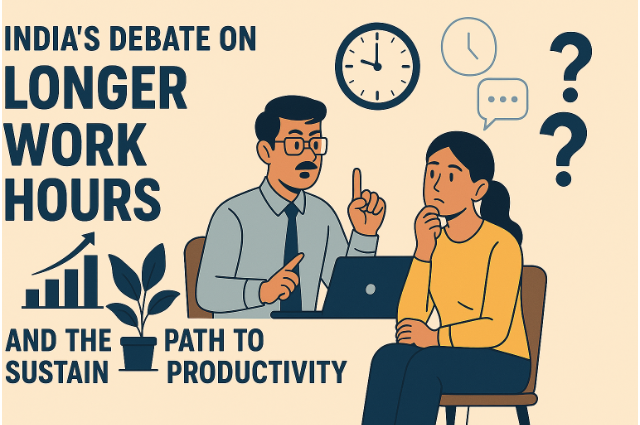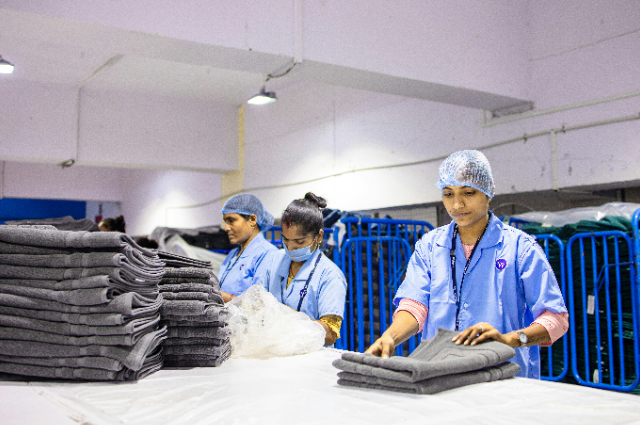
India stands at a critical economic juncture. With aspirations to become a global economic powerhouse and move closer to the status of a developed economy, questions around labor productivity, workforce efficiency, and working conditions have taken center stage. One of the most controversial proposals currently under discussion is the suggestion to increase work hours from the standard 8-hour day to a potential 12-hour shift framework.
This idea has sparked a fierce debate across industry circles, labor unions, policy think tanks, and the general public. Proponents argue that increased work hours will boost productivity, improve economic output, and bring India in line with the expectations of global capital markets. Opponents, however, raise red flags around worker exploitation, mental and physical burnout, and diminishing returns on productivity.
This article explores the nuances of this debate, weighing its pros and cons, examining global standards, and proposing balanced solutions that can serve both economic and humanitarian goals.
The Case for Longer Work Hours: Economic Imperatives and Efficiency
Those in favor of extending the workday believe that such a move is essential for India to leapfrog its current productivity constraints. India, despite having one of the largest workforces in the world, lags behind in per capita productivity when compared to developed nations.
- Productivity Boost Proponents argue that increased working hours, especially in sectors like manufacturing, can lead to higher output without the need for immediate capital expansion. Kiran Mazumdar-Shaw, Executive Chairperson of Biocon Limited, has supported the idea in the context of industrial efficiency, stating that flexible work hours could enhance output if implemented wisely. They emphasize that time is a finite resource, and in a country where job creation needs to outpace population growth, maximizing work hours can seem like an attractive solution.
- Economic Growth and Global Competitiveness India aims to be a $5 trillion economy by the end of this decade. Industry leaders argue that such ambition demands a rethinking of traditional labor models. "We must align our productivity models with those of global giants if we are to compete with them," said TV Mohandas Pai, former CFO of Infosys and Chairman of Arin Capital. Pai supports longer hours in specific sectors, particularly in startups and high-growth areas where time equates to competitive advantage. For many business leaders, time is money, and the extended workday represents an untapped well of potential.
- Flexibility in Shift Work: Some argue that allowing for 12-hour shifts—provided they are optional and rotational—could actually benefit both employers and employees by reducing the number of working days in a week. This has already been suggested in Karnataka’s labor reforms. For instance, a four-day workweek comprising 12-hour shifts may offer employees extended weekends, creating more time for family, upskilling, or rest.
- Attraction of Foreign Investment Longer work shifts, if strategically deployed in export-oriented industries, could present India as a more attractive destination for foreign direct investment (FDI). Multinational corporations often prefer consistent and scalable output, and such a model could help India rival manufacturing hubs like Vietnam and Indonesia.
The Counterargument: Human Costs and Ethical Considerations
Labor unions and social activists, however, argue that this model comes at a human cost that could erode the very productivity it seeks to enhance.
- Health Implications and Burnout: The WHO has linked long working hours to increased risks of heart disease and stroke. Prolonged workweeks often correlate with mental fatigue, sleep deprivation, and a decline in overall well-being. Dr. Vandana Shiva, an environmentalist and social activist, warns that productivity gains from longer hours may be illusory: "Overwork leads to stress, which leads to inefficiency, which undermines productivity." Mental health advocates caution against glamorizing hustle culture, especially in urban tech corridors like Bengaluru, where employees already face high levels of stress. In such environments, the pursuit of deadlines often comes at the cost of downtime, deep thinking, and creativity.
- Diminishing Returns Contrary to popular belief, beyond a certain point, longer work hours actually decrease productivity. Research by Stanford University shows that output per hour declines sharply when a person works more than 50 hours a week. Past the 70-hour mark, productivity drops so drastically that extra hours become practically useless. The concept of diminishing marginal returns applies starkly to human labor.
- Worker Exploitation Without adequate compensation, increasing work hours can easily devolve into exploitation. Labor economist Dr. Santosh Mehrotra warns that unless laws mandate overtime pay and enforce compliance, longer workdays could further deepen income inequality and social unrest. In the absence of proper legal safeguards, the most vulnerable workers—women, migrants, contractual labor—may find themselves coerced into longer hours of out real benefits.
- Gendered Impact: Women may be disproportionately affected by this change. With existing domestic responsibilities, longer hours at work can make formal employment nearly impossible for many women, pushing them further into informal and precarious jobs.
Global Benchmarks: What Developed Economies Are Doing
Comparing India's debate to global practices offers critical insights. Most developed economies adhere to a 35- to 40-hour workweek, and many are exploring reduced hours, not more.
- France and the 35-Hour Week France implemented a 35-hour workweek in 2000 to tackle unemployment and improve quality of life. Despite criticism, it has led to increased productivity per hour and a better work-life balance. Employers retain flexibility through permitted overtime.
- Germany’s Focus on Efficiency: Germany's workforce averages about 34 hours per week, yet the country remains an industrial and economic powerhouse. The German model emphasizes high productivity per hour, robust worker protections, and extensive vocational training. Their economy thrives on precision, automation, and innovation, not brute labor.
- Scandinavia and Work-Life Balance: In Sweden and Norway, average weekly work hours are among the lowest globally, yet living standards and per capita incomes are high. These countries focus on innovation, automation, and strong public services to sustain productivity. They see rest, recreation, and personal time as essential inputs for creative and strategic thinking.
- Japan’s Hard Lesson: Japan, once the poster child for extreme work hours, has recently introduced laws to cap overtime after rising suicide rates attributed to "karoshi" or death from overwork. It serves as a cautionary tale of what not to emulate.
India’s Unique Challenges and Opportunities

Photo by EqualStock on Unsplash
India cannot transplant Western models wholesale due to differences in demographics, income levels, and industry structures. However, there are learnings to be adapted.
- Informal Sector Dominance: Nearly 90% of India’s workforce is employed in the informal sector, where labor laws are poorly enforced. Increasing work hours in this context could worsen already exploitative conditions unless serious regulatory mechanisms are put in place. For these workers, increased hours often mean more exposure to unsafe working conditions, greater fatigue, and little to no financial gain.
- Tech and Automation: India’s growing IT and services sectors thrive on talent, not time. Here, longer hours may not equate to higher output. Instead, innovation, skill development, and flexible work arrangements hold more promise. Productivity here is mental, not mechanical.
- Youthful Workforce: India has a demographic dividend—its workforce is among the youngest in the world. Harnessing this energy should involve skilled and smart deployment, not long drudgery hours. Young professionals today seek meaningful work, autonomy, and balance.
- Regional Disparities: Work culture, access to technology, and labor law enforcement vary widely between Indian states. A one-size-fits-all approach may not be practical or effective.
Proposed Solutions: Balancing Growth with Worker Welfare
To achieve sustainable productivity, India must adopt a balanced approach that respects both economic imperatives and human dignity.
- Flexibility, Not Uniformity Implement flexible work models that allow employees to choose between longer shifts and compressed workweeks, but only with safeguards like double pay for overtime, mandatory rest days, and voluntary participation. The right to disconnect after hours should also be legally recognized.
- Skilling and Upskilling: Rather than squeezing more hours, India should focus on increasing productivity per hour. This can be achieved through investments in training, digital tools, and process optimization. A smarter workforce is a more productive one.
- Better Enforcement of Labor Codes: New labor codes should include clear clauses around compensation, health safeguards, and monitoring mechanisms to prevent abuse. Technology like digital attendance can aid enforcement. Workers should be empowered to report violations without fear.
- Sector-Specific Policies: A blanket approach won't work. Manufacturing might benefit from shift extensions, while the knowledge economy needs flexibility and creative freedom. Policies should be tailored to sectoral needs. In agricultural and seasonal work, completely different models may apply.
- Mental Health Initiatives Companies and the government must invest in mental health infrastructure, offer employee counselling, and normalize mental wellness as a metric of workplace success. Organizations should integrate rest, purpose, and autonomy into their work design.
- Dialogue and Participation Policy-making should involve multiple stakeholders—workers, employers, government bodies, health experts, and civil society. Co-created labor laws are more likely to succeed than top-down mandates.
Voices from the Ground: Employees and Industry Weigh In
Ravi Kumar, a machine operator in a Chennai factory, says: "I already work 10 hours with overtime. If it becomes compulsory, when will I see my family? We need better pay, not longer shifts."
On the other hand, Anjali Mehta, founder of a startup in Bengaluru, remarks: "We’re in a high-growth phase. If team members are willing, we should be able to opt for longer hours. But yes, burnout is real, and we try to balance it with time-off policies."
Shalini Roy, an HR manager in Mumbai, adds: "Productivity is not about hours clocked. It’s about how engaged and healthy your team is. We need a model that respects both ambition and humanity."
Conclusion: Towards a More Equitable Work Future
The debate around longer work hours is emblematic of a broader challenge—how can India grow without compromising the dignity, health, and happiness of its workers? Economic progress must not be predicated on human suffering. The path forward lies not in working more, but in working smarter.
The real productivity revolution will not come from the clock, but from innovation, equity, and a people-first approach. India must look to create workplaces where efficiency and empathy co-exist, where economic ambition is matched with social responsibility. Only then can we call ourselves truly developed.
In the long run, nations are remembered not just for how fast they grew, but for how fairly they treated those who built that growth brick by brick. Let India not trade off well-being for wealth, but seek both, together, in harmony.
